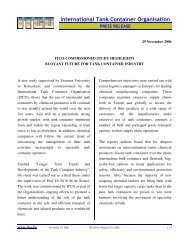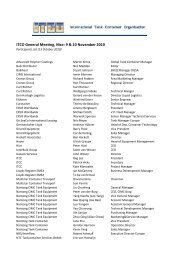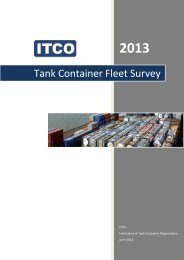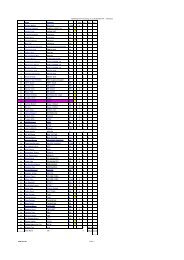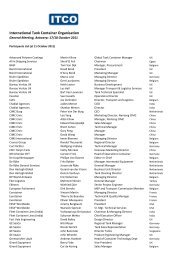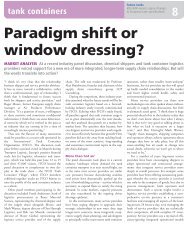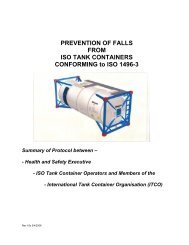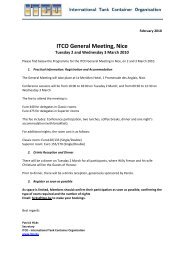You also want an ePaper? Increase the reach of your titles
YUMPU automatically turns print PDFs into web optimized ePapers that Google loves.
ICHCA International <strong>Safe</strong>ty Panel Briefing Pamphlet No 30<br />
9.3.4 Beer <strong>Tank</strong>s<br />
One particular non regulated food grade commodity is beer. This has special<br />
requirements.<br />
9.3.4.1 Firstly all tanks built for the carriage <strong>of</strong> beer are generally built with inert gas<br />
lines (usually CO2) and a system for thoroughly cleaning the interior <strong>of</strong> the<br />
shell known as a “clean in place” (CIP) system.<br />
9.3.4.2 Access to the pressure vessel is through a special elliptical manway lid<br />
which has an “In / Out” construction. This means that to remove the lid, it<br />
must be released, pushed into the pressure vessel and then pulled out by<br />
re-orientating the lid through 90˚. The manway is usually mounted in the<br />
head (end) <strong>of</strong> the tank.<br />
9.3.4.3 The valves and fittings differ from type to type. Individual breweries have<br />
differing standards and it would not be possible to cover all versions within<br />
the scope <strong>of</strong> this pamphlet.<br />
Note 1: Although beer tanks do not count as dangerous goods tanks they<br />
are always under pressure; the gas causing the pressure, usually<br />
CO2, is an asphyxiant and could cause death through inhalation in<br />
confined spaces if released.<br />
Note 2: Sometimes the ullage space <strong>of</strong> tank containers may be filled with a<br />
“nitrogen blanket”. This may happen with tank containers used for<br />
the transport <strong>of</strong> dangerous goods and non-dangerous cargoes.<br />
Whilst the pressure <strong>of</strong> this gas is too low to cause it to be<br />
considered as a dangerous good, the presence <strong>of</strong> such gases in<br />
the ullage space or in empty, unclean tank containers, may produce<br />
an asphyxiation danger.<br />
9.4 Non regulated cargoes would not normally require the tank container to be<br />
marked with any decal or placard to indicate the cargo carried.<br />
10 Lifting and Carrying<br />
10.1 Basic issues<br />
10.1.1 See International <strong>Safe</strong>ty Panel Briefing Pamphlet No. 5 Container Terminal<br />
<strong>Safe</strong>ty for more information on lifting and carrying in terminals<br />
10.1.2 For the purposes <strong>of</strong> lifting and carrying, tank containers should be<br />
considered to be the same as other container types and all the general<br />
issues <strong>of</strong> safe handling apply. Those issues are not the subject <strong>of</strong> this<br />
pamphlet , however, it does concentrates on the specific aspects that relate<br />
to tank containers.<br />
10.1.3 In some types <strong>of</strong> operation it may be an acceptable practice to insert semi<br />
automatic twistlocks (SATLs) into the bottom corner fittings to stack<br />
containers safely, please refer to 11.6<br />
10.1.4 However, this method <strong>of</strong> work creates an interface between mobile<br />
equipment and pedestrians and requires great care to preclude pedestrian –<br />
machine collisions where there is an inherent risk <strong>of</strong> serious or fatal injuries<br />
to personnel on foot<br />
10.2 General<br />
10.2.1 A risk assessment using a hierarchy <strong>of</strong> controls as advised by the safety<br />
management should be undertaken by each terminal to determine the safest<br />
way to handle, carry and stack tank containers.<br />
Page 31 ©ICHCA International Limited



